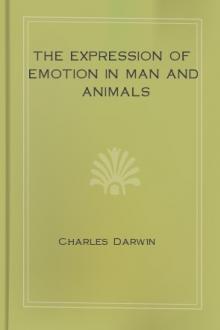The Expression of Emotion in Man and Animals, Charles Darwin [snow like ashes series txt] 📗

- Author: Charles Darwin
- Performer: -
Book online «The Expression of Emotion in Man and Animals, Charles Darwin [snow like ashes series txt] 📗». Author Charles Darwin
The man was old, clumsy, poor, and ragged, and the idea of his driving himself about in his carriage for display amused Mr. Stack so much that he could not help bursting out into a laugh; and then “the old man blushed up to the roots of his hair.”
Forster says that “you may easily distinguish a spreading blush”
on the cheeks of the fairest women in Tahiti.[12] The natives also of several of the other archipelagoes in the Pacific have been seen to blush.
[10] `Letters from Egypt,’ 1865, p. 66. Lady Gordon is mistaken when she says Malays and Mulattoes never blush.
[11] Capt. Osborn (`Quedah,’ p. 199), in speaking of a Malay, whom be reproached for cruelty, says he was glad to see that the man blushed.
Mr. Washington Matthews has often seen a blush on the faces of the young squaws belonging to various wild Indian tribes of North America. At the opposite extremity of the continent in Tierra del Fuego, the natives, according to Mr. Bridges, “blush much, but chiefly in regard to women; but they certainly blush also at their own personal appearance.” This latter statement agrees with what I remember of the Fuegian, Jemmy Button, who blushed when he was quizzed about the care which he took in polishing his shoes, and in otherwise adorning himself.
With respect to the Aymara Indians on the lofty plateaus of Bolivia, Mr. Forbes says,[13] that from the colour of their skins it is impossible that their blushes should be as clearly visible as in the white races; still under such circumstances as would raise a blush in us, “there can always be seen the same expression of modesty or confusion; and even in the dark, a rise of temperature of the skin of the face can be felt, exactly as occurs in the European.” With the Indians who inhabit the hot, equable, and damp parts of South America, the skin apparently does not answer to mental excitement so readily as with the natives of the northern and southern parts of the continent, who have long been exposed to great vicissitudes of climate; for Humboldt quotes without a protest the sneer of the Spaniard, “How can those be trusted, who know not how to blush?”[14] Von Spix and Martius, in speaking of the aborigines of Brazil, assert that they cannot properly be said to blush; “it was only after long intercourse with the whites, and after receiving some education, that we perceived in the Indians a change of colour expressive of the emotions of their minds.”[15]
It is, however, incredible that the power of blushing could have thus originated; but the habit of self-attention, consequent on their education and new course of life, would have much increased any innate tendency to blush.
[12] J. R. Forster, `Observations during a Voyage round the World,’
4to, 1778, p. 229. Waitz gives (`Introduction to Anthropology,’ Eng.
translat. 1863, vol. i. p. 135) references for other islands in the Pacific. See, also, Dampier `On the Blushing of the Tunquinese’
(vol. ii. p. 40); but I have not consulted this work.
Waitz quotes Bergmann, that the Kalmucks do not blush, but this may be doubted after what we have seen with respect to the Chinese. He also quotes Roth, who denies that the Abyssinians are capable of blushing.
Unfortunately, Capt. Speedy, who lived so long with the Abyssinians, has not answered my inquiry on this head. Lastly, I must add that the Rajah Brooke has never observed the least sign of a blush with the Dyaks of Borneo; on the contrary under circumstances which would excite a blush in us, they assert “that they feel the blood drawn from their faces.”
[13] Transact. of the Ethnological Soc. 1870, vol. ii. p. 16.
Several trustworthy observers have assured me that they have seen on the faces of negroes an appearance resembling a blush, under circumstances which would have excited one in us, though their skins were of an ebony-black tint. Some describe it as blushing brown, but most say that the blackness becomes more intense. An increased supply of blood in the skin seems in some manner to increase its blackness; thus certain exanthematous diseases cause the affected places in the negro to appear blacker, instead of, as with us, redder.[16] The skin, perhaps, from being rendered more tense by the filling of the capillaries, would reflect a somewhat different tint to what it did before.
That the capillaries of the face in the negro become filled with blood, under the emotion of shame, we may feel confident; because a perfectly characterized albino negress, described by Buffon,[17] showed a faint tinge of crimson on her cheeks when she exhibited herself naked.
Cicatrices of the skin remain for a long time white in the negro, and Dr. Burgess, who had frequent opportunities of observing a scar of this kind on the face of a negress, distinctly saw that it “invariably became red whenever she was abruptly spoken to, or charged with any trivial offence.”[18] The blush could be seen proceeding from the circumference of the scar towards the middle, but it did not reach the centre.
Mulattoes are often great blushers, blush succeeding blush over their faces.
From these facts there can be no doubt that negroes blush, although no redness is visible on the skin.
[14] Humboldt, `Personal Narrative,’ Eng. translat. vol. iii. p. 229.
[15] Quoted by Prichard, Phys. Hist. of Mankind, 4th edit 1851, vol. i. p. 271.
[16] See, on this head, Burgess, ibid. p. 32. Also Waitz, `Introdnction to Anthropology,’ Eng. edit. vol. i. p. 139. Moreau gives a detailed account (`Lavater,’ 1820, tom. iv. p. 302) of the blushing of a Madagascar negress-slave when forced by her brutal master to exhibit her naked bosom.
I am assured by Gaika and by Mrs. Barber that the Kafirs of South Africa never blush; but this may only mean that no change of colour is distinguishable.
Gaika adds that under the circumstances which would make a, European blush, his countrymen “look ashamed to keep their heads up.”
It is asserted by four of my informants that the Australians, who are almost as black as negroes, never blush. A fifth answers doubtfully, remarking that only a very strong blush could be seen, on account of the dirty state of their skins.
Three observers state that they do blush;[19] Mr. S. Wilson adding that this is noticeable only under a strong emotion, and when the skin is not too dark from long exposure and want of cleanliness.
Mr. Lang answers, “I have noticed that shame almost always excites a blush, which frequently extends as low as the neck.” Shame is also shown, as he adds, “by the eyes being turned from side to side.”
As Mr. Lang was a teacher in a native school, it is probable that he chiefly observed children; and we know that they blush more than adults. Mr. G. Taplin has seen half-castes blushing, and he says that the aborigines have a word expressive of shame.
Mr. Hagenauer, who is one of those who has never observed the Australians to blush, says that he has “seen them looking down to the ground on account of shame;” and the missionary, Mr. Bulmer, remarks that though “I have not been able to detect anything like shame in the adult aborigines, I have noticed that the eyes of the children, when ashamed, present a restless, watery appearance, as if they did not know where to look.”
[17] Quoted by Prichard, Phys. Hist. of Mankind, 4th edit.
1851, vol. i. p. 225.
[18] Burgess, ibid. p. 31. On mulattoes blushing, see p. 33. I have received similar accounts with respect to, mulattoes.
[19] Barrington also says that the Australians of New South Wales blush, as quoted by Waitz, ibid. p. 135.
The facts now given are sufficient to show that blushing, whether or not there is any change of colour, is common to most, probably to all, of the races of man.
Movements and gestures which accompany Blushing.—Under a keen sense of shame there is a, strong desire for concealment.[20] We turn away the whole body, more especially the face, which we endeavour in some manner to hide.
An ashamed person can hardly endure to meet the gaze of those present, so that he almost invariably casts down his eyes or looks askant.
As there generally exists at the same time a strong wish to avoid the appearance of shame, a vain attempt is made to look direct at the person who causes this feeling; and the antagonism between these opposite tendencies leads to various restless movements in the eyes.
I have noticed two ladies who, whilst blushing, to which they are very liable, have thus acquired, as it appears, the oddest trick of incessantly blinking their eyelids with extraordinary rapidity. An intense blush is sometimes accompanied by a slight effusion of tears;[21] and this, I presume, is due to the lacrymal glands partaking of the increased supply of blood, which we know rushes into the capillaries of the adjoining parts, including the retina.
[20] Mr. Wedgwood says (Dict. of English Etymology, vol. iii. 1865, p.
155) that the word shame “may well originate in the idea of shade or concealment, and may be illustrated by the Low German scheme, shade or shadow.” Gratiolet (De la Phys. pp. 357-362) has a good discussion on the gestures accompanying shame; but some of his remarks seem to me rather fanciful. See, also, Burgess (ibid. pp.
69, 134) on the same subject.
Many writers, ancient and modern, have noticed the foregoing movements; and it has already been shown that the aborigines in various parts of the world often exhibit their shame by looking downwards or askant, or by restless movements of their eyes.
Ezra cries out (ch. ix. 6), “O, my God! I am ashamed, and blush to lift up my head to thee, my God.” In Isaiah (ch. I. 6) we meet with the words, “I hid not my face from shame.”
Seneca remarks (Epist. xi. 5) “that the Roman players hang down their heads, fix their eyes on the ground and keep them lowered, but are unable to blush in acting shame.” According to Macrobius, who lived in the filth century (`Saturnalia,’ B. vii.
C. 11), “Natural philosophers assert that nature being moved by shame spreads the blood before herself as a veil, as we see any one blushing often puts his hands before his face.”
Shakspeare makes Marcus (`Titus Andronicus,’ act ii, sc. 5) say to his niece, “Ah! now thou turn’st away thy face for shame.”
A lady informs me that she found in the Lock Hospital a girl whom she had formerly known, and who had become a wretched castaway, and the poor creature, when approached, hid her face under the bed-clothes, and could not be persuaded to uncover it.
We often see little children, when shy or ashamed, turn away, and still standing up, bury their faces in their mother’s gown; or they throw themselves face downwards on her lap.
[21] Burgess, ibid. pp. 181, 182. Boerhaave also noticed (as quoted by Gratiolet, ibid. p. 361) the tendency to the secretion of tears during intense blushing.
Mr. Bulmer, as we have seen, speaks of the “watery eyes”
of the children of the Australian aborigines when ashamed.





Comments (0)